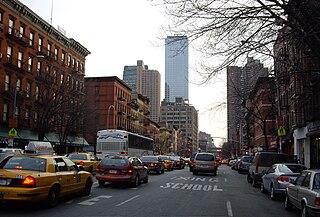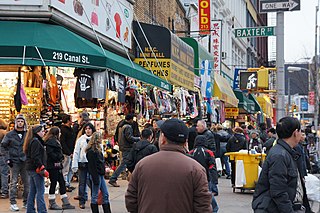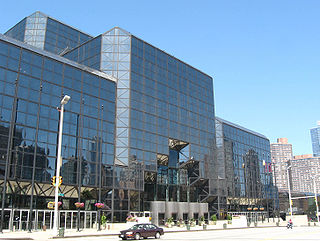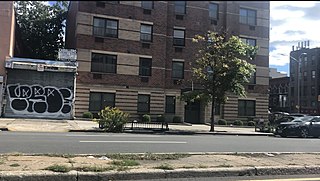
Harlem is a neighborhood in Upper Manhattan, New York City. It is bounded roughly by the Hudson River on the west; the Harlem River and 155th Street on the north; Fifth Avenue on the east; and Central Park North on the south. The greater Harlem area encompasses several other neighborhoods and extends west and north to 155th Street, east to the East River, and south to Martin Luther King Jr. Boulevard, Central Park, and East 96th Street.

42nd Street is a major crosstown street in the New York City borough of Manhattan, spanning the entire breadth of Midtown Manhattan, from Turtle Bay at the East River, to Hell's Kitchen at the Hudson River on the West Side. The street hosts some of New York's best known landmarks, including the headquarters of the United Nations, the Chrysler Building, Grand Central Terminal, the New York Public Library Main Branch, Times Square, and the Port Authority Bus Terminal.

Hell's Kitchen, also known as Clinton, is a neighborhood on the West Side of Midtown Manhattan in New York City. It is considered to be bordered by 34th Street to the south, 59th Street to the north, Eighth Avenue to the east, and the Hudson River to the west.

Canal Street is a major east–west street of over 1 mile (1.6 km) in Lower Manhattan, New York City, running from East Broadway between Essex and Jefferson Streets in the east, to West Street between Watts and Spring Streets in the west. It runs through the neighborhood of Chinatown, and forms the southern boundaries of SoHo and Little Italy as well as the northern boundary of Tribeca. The street acts as a major connector between Jersey City, New Jersey, via the Holland Tunnel (I-78), and Brooklyn in New York City via the Manhattan Bridge. It is a two-way street for most of its length, with two unidirectional stretches between Forsyth Street and the Manhattan Bridge.

23rd Street is a broad thoroughfare in the New York City borough of Manhattan, one of the major two-way, east-west streets in the borough's grid. As with Manhattan's other "crosstown" streets, it is divided into its east and west sections at Fifth Avenue. The street runs from Avenue C and FDR Drive in the east to Eleventh Avenue in the west.
Johnny Spanish was an American gangster who was a rival of former partner "Kid Dropper" Nathan Kaplan during a garment workers' strike which later become known as the Second Labor Sluggers War in 1919. He became involved in labor racketeering, holdups of saloons and other businesses, and murder before organizing his own gang.

The Lenox Avenue Gang was an early 20th-century New York City street gang led by Harry Horowitz; it was considered one of the most violent gangs of the pre-Prohibition era. It was based in Harlem in Upper Manhattan, New York City, around 125th Street, in what was then a predominantly Jewish neighborhood.

Tenth Avenue, known as Amsterdam Avenue between 59th Street and 193rd Street, is a north-south thoroughfare on the West Side of Manhattan in New York City. It carries uptown (northbound) traffic as far as West 110th Street, after which it continues as a two-way street.

Eleventh Avenue is a north–south thoroughfare on the far West Side of the borough of Manhattan in New York City, located near the Hudson River. Eleventh Avenue originates in the Meatpacking District in the Greenwich Village and West Village neighborhoods at Gansevoort Street, where Eleventh Avenue, Tenth Avenue, and West Street intersect. It is considered part of the West Side Highway between 22nd and Gansevoort Streets.

The Gopher Gang was an early 20th-century New York street gang who counted among its members Goo Goo Knox, James "Biff" Ellison, and Owney Madden, born in England of Irish ancestry. Based in the Irish neighborhood of Hell's Kitchen, the Gopher Gang grew to control most of Manhattan with their territory covering Fourth to Forty-Second Street and Seventh to Eleventh Avenue.
The Dutch Mob was a New York pickpocket gang during the late nineteenth century.

Crime rates in New York City have been recorded since at least the 1800s. They have spiked ever since the post-war period. The highest crime totals were recorded in the late 1980s and early 1990s as the crack epidemic surged, and then declined continuously through the 2000s.
The Gas House Gang was a New York City street gang during the late nineteenth century.

The Eastman Gang was the last of New York's street gangs which dominated the city's underworld during the late 1890s until the early 1910s. Along with the Five Points Gang under Italian-American Paolo Antonio Vaccarelli, best known as Paul Kelly, the Eastman gang succeeded the long dominant Whyos as the first non-Irish street gang to gain prominence in the underworld during the 1890s. Its rise marked the beginning of a forty to fifty-year period of strong Jewish-American influence within organized crime in New York City.
The East Harlem Purple Gang was a gang or organized crime group consisting of Italian-American hit-men and heroin dealers who were semi-independent from the Italian-American Mafia and, according to federal prosecutors, dominated heroin distribution in East Harlem, Italian Harlem, and the Bronx during the 1970s and early 1980s in New York City. Though mostly independent of the Italian-American Mafia and not an official Mafia crew, the gang was originally affiliated with and worked with the Lucchese crime family and later with the Bonanno crime family and Genovese crime family. It developed its "closest ties" with the Genovese family, and its remnants or former members are now part of the Genovese family's 116th Street Crew.

Allen Street is a street in the New York City borough of Manhattan which runs north-south through the Lower Manhattan neighborhood of Chinatown and the Lower East Side. It is continued north of Houston Street as First Avenue. South of Division Street, it is known as Pike Street to its southern terminus at South Street. The northbound and southbound roadways are separated by a meridian mall, which has two bike lanes located outside the meridian mall; each bike lane is unidirectional. The street's namesake was Master Commandant William Henry Allen, the youngest person to command a Navy ship in the War of 1812. He was killed in action at the age of 28. His exploits included the capture of the British ship HMS Macedonian.
Henry D. Neuman or Neumann was a German-born American burglar, bank robber and gang leader known as Dutch Heinrichs. A member of Chauncey Johnson's burglary gang during the late 1860s, he was also the founder of the Hell's Kitchen Gang which terrorized West Manhattan for over two decades.
The Whittemore Gang was a group of bank robbers active in the Mid-Atlantic and Eastern United States during the mid-1920s. Led by Richard Reese Whittemore, the gang, including his wife Margaret, went on a year-long crime spree committing payroll, bank and jewelry robberies in Maryland and New York before their capture in 1926.
Frank "Chick" Tricker was an early New York gangster who, as a member of the Eastman Gang, served as one of its last leaders alongside Jack Sirocco.